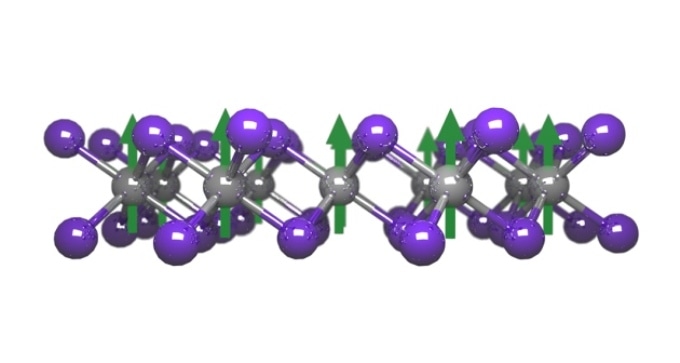Jun 8 2017
Magnetic materials are considered to be the foundation of technologies that presently play extremely crucial roles in the lives of human beings. Their significance is also seen in hard-disk data storage and sensing.
However, since the innovative dreams of individuals conjure wishes for faster and ever-smaller devices, Researchers are currently looking out for magnetic materials that are more efficient, more compact and can be controlled using reliable, precise methods.
 Side view of the latest 2-D material. Efren Navarro-Moratalla (Credit: University of Washington)
Side view of the latest 2-D material. Efren Navarro-Moratalla (Credit: University of Washington)
For the very first time, a team headed by the University of Washington and the Massachusetts Institute of Technology has discovered magnetism in the 2D world of monolayers (materials that are developed by just one atomic layer). The outcomes have been published in the June 8th issue of the journal Nature, and these findings show that magnetic properties can be present in the 2D realm, thus opening a whole new world of promising applications.
What we have discovered here is an isolated 2-D material with intrinsic magnetism, and the magnetism in the system is highly robust. We envision that new information technologies may emerge based on these new 2-D magnets.
Xiaodong Xu, a UW professor of Physics and of Materials Science and Engineering
Pablo Jarillo-Herrero , Xu and MIT Physics Professor, headed the global team of Scientists who established that the material, chromium triiodide (CrI3), contains magnetic properties in its monolayer form.
Other groups, including co-Author Michael McGuire at the Oak Ridge National Laboratory, had earlier demonstrated that CrI3 is ferromagnetic in its multilayered, 3D, bulk crystal form. The “spins” of constituent electrons, similar to small, subatomic magnets, are situated in the same direction even without an external magnetic field in ferromagnetic materials.
However, no 3D magnetic substance had earlier retained its magnetic properties when thinned down to just one atomic sheet. Monolayer materials can in fact demonstrate novel properties not observed in their multilayered, 3D forms.
You simply cannot accurately predict what the electric, magnetic, physical or chemical properties of a 2-D monolayer crystal will be based on the behavior of its 3-D bulk counterpart.
Bevin Huang,UW Doctoral Student and Co-Author
Atoms present within monolayer materials are “functionally” considered to be 2D because the electrons are capable of traveling only within the atomic sheet, just like pieces on a chessboard.
The team discovered the properties of CrI3 in its 2D form by using Scotch tape for shaving a monolayer of CrI3 off the bigger, 3D crystal form.
Using Scotch tape to exfoliate a monolayer from its 3-D bulk crystal is surprisingly effective. This simple, low-cost technique was first used to obtain graphene, the 2-D form of graphite, and has been used successfully since then with other materials.
Genevieve Clark, Co-lead Author and UW Doctoral Student
When a beam of polarized light is reflected off the material’s surface, the aligned spins of electrons, in ferromagnetic materials leave a tell-tale signature. The team identified this signature in CrI3 by using a special type of microscopy. It is considered to be the first definitive sign of intrinsic ferromagnetism in an isolated monolayer.
Surprisingly, optical signature disappeared in CrI3 flakes that are two layers thick. This highlights that the electron spins are oppositely aligned to one another, a term called anti-ferromagnetic ordering. Ferromagnetism returned in three-layer CrI3. The Researchers will need to carry out further studies in order to understand why CrI3 displayed these incredible layer-dependent magnetic phases. But to Xu, these are only some of the truly exceptional properties exposed by combining monolayers.
“2-D monolayers alone offer exciting opportunities to study the drastic and precise electrical control of magnetic properties, which has been a challenge to realize using their 3-D bulk crystals,” said Xu. “But an even greater opportunity can arise when you stack monolayers with different physical properties together. There, you can get even more exotic phenomena not seen in the monolayer alone or in the 3-D bulk crystal.”
A huge volume of Xu’s research focuses on developing heterostructures, which are stacks of two varied ultrathin materials. His team, at the interface between the two materials, seeks for new functions or for new physical phenomena in order to permit potential applications in information and computing technologies.
On May 31st, in a related advance, Xu’s research group, UW Electrical Engineering and Physics Professor Kai-Mei Fu and a team of colleagues published a paper demonstrating that an ultrathin form of CrI3 produces an ultraclean “heterostructure” interface with unexpected and unique magnetic and photonic properties when stacked with a monolayer of tungsten diselenide.
“Heterostructures hold the greatest promise of realizing new applications in computing, database storage, communications and other applications we cannot even fathom yet,” said Xu.
In the future, Xu and his team plan to examine the magnetic properties unique to 2D magnets and heterostructures that comprise of CrI3 monolayer or bilayer.
MIT Researcher Efren Navarro-Moratalla is the third Co-lead Author on the Nature paper. Other Co-Authors include Dahlia Klein at MIT; Ran Cheng and Di Xiao at Carnegie Mellon University; Kyle Seyler, Ding Zhong, Emma Schmidgall and David Cobden at the UW; and Wang Yao at the University of Hong Kong. Co-lead Authors on the Science Advances paper are Seyler, Zhong and Xiayu Linpeng, who are all UW Doctoral Students.
The Department of Energy and a University of Washington Innovation Award funded the UW Researchers for the Nature publication.